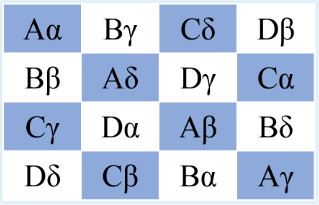The Complete History of Sudoku
Fast Forward 3,700 Years
Latin Square - in the 1700s Switzerland’s Leonhard Euler, a mathematician, mused on removing the summation rule in magic squares. The result was ‘Graeco-Roman Squares’ or ‘Latin squares’ which were the next step in the evolution toward the sudoku puzzle. These squares were on a 4 x 4 grid where each cell had one of four Latin letters and one of four Greek letters. The solution was to arrange the letters so that each row and each column contained all four Latin and all four Greek letters with no duplicates.
Latin squares started to look more like what we know as sudoku today.

See it. In this Latin square, no row or column has more than one of each Latin letter and one of each Greek letter.
Next: France's Contribution to Sudoku > >
If Sudoku Primer and the YouTube channel have helped you, consider donating a little

Thanks in advance for your support!
More About Sudoku
Sudoku - the puzzle that addicts
